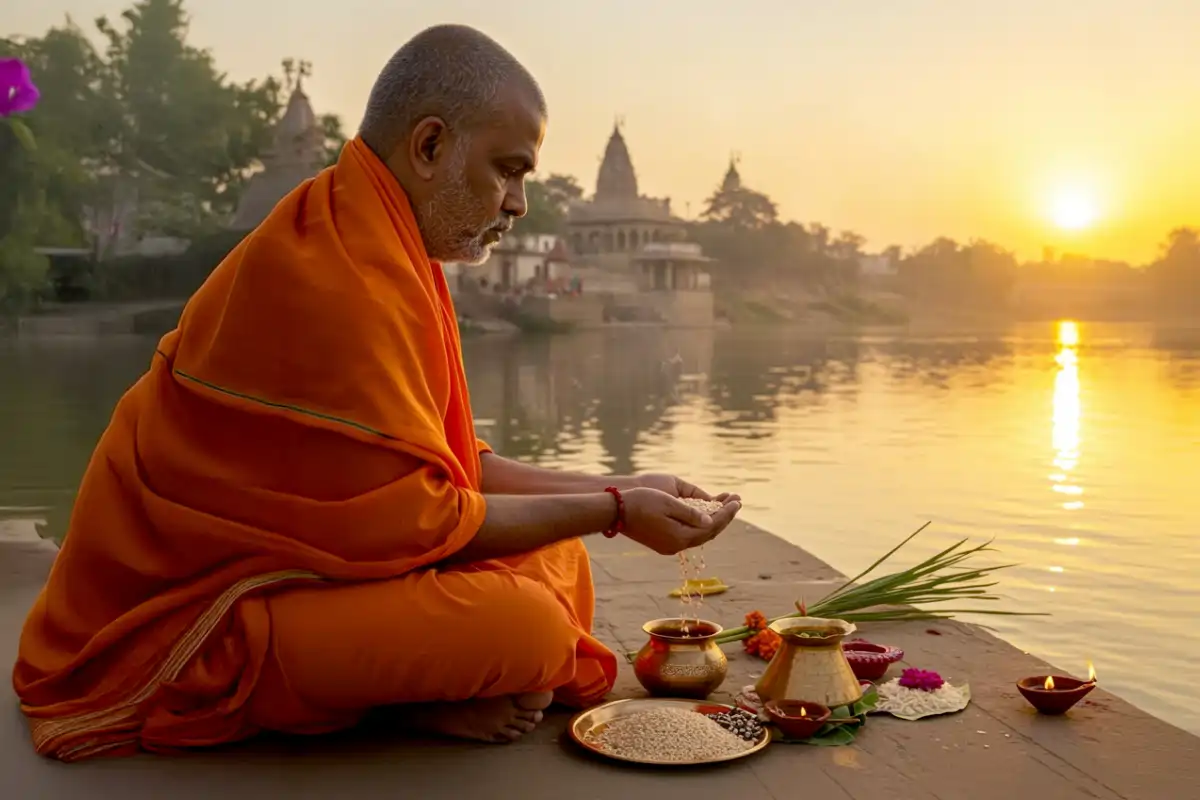
Each year, when the monsoon rains start to slow down, a special time in the Hindu calendar begins. This is Shraddha Paksha, also known as Pitru Paksha. It lasts for 16 lunar days. This time is focused on honouring ancestors, not gods. For many, it’s a time for reflection. We take a moment from our hectic lives to express gratitude for our ancestors.
Let’s know more about the Shraddha Paksha meaning, importance and its rituals.
What is the Shraddha Paksha?
Shraddha Paksha is a special spiritual period that occurs during the Hindu month of Bhadrapada, which typically falls in September or October. It is a time to pay respect to our ancestors, whom we call Pitrs. The word “Shraddha” is derived from Sanskrit. It means to do something with true faith and devotion.
The core belief is that for 16 days, the souls of our last three generations come down from Pitru-loka. They stay with their families on Earth, waiting for offerings.
It is a time to acknowledge the “Pitru Rin,” or the debt we owe to our ancestors for giving us life, values, and a lineage.
What Makes Shraddha Paksh 2025 Significant?
The essence of Shraddha Paksha 2025 goes beyond rituals. It’s a time of spirituality, gratitude and remembrance. It reminds us of our origins and the importance of gratitude. By honouring our ancestors, we strengthen our relationships and grow spiritually. It teaches us to live with humility and righteousness.
Key Rituals and Practices
Rituals vary by region and family, but some key practices are common everywhere during this time.
-
Tarpan
This is a traditional ritual to show thanks to ancestors and deities. Tarpan is the act of offering water mixed with black sesame seeds (til), barley and other substances to the ancestors. While offering the water, the names of the deceased from the father’s and mother’s lineages are recited. This simple act symbolises giving peace to the departed souls and quenching their thirst.
-
Pind Daan
This is the most significant ritual of Shraddha Paksh 2025. A Pind is a ball made of cooked rice, barley flour, ghee, and black sesame seeds. We dedicate this offering to our ancestors: our father, grandfather, great-grandfather, and their spouses. Pind Daan stands for nourishment for souls. It empowers them and helps in their spiritual journey.
-
Brahmin Bhoj (Feeding the Priests)
On the day that marks the ancestor’s death, families invite Brahmin priests to their homes. They receive a respectful, pure vegetarian food (sattvic food). It’s made with the same care as an offering to the gods. People believe that whatever the Brahmins receive goes directly to the ancestors.
-
Offering Food to Animals
This time is all about showing kindness to every living being. On these days, a short part of food is given to a crow. People saw crows as messengers between the living and the ancestors. Then, it is offered to the holy cow, and finally to a dog. This act does not limit the spirit of charity and service to humans alone, but makes it even more pervasive.
Lunar Eclipse During Shraddha Paksha
This year, it’s an astronomically significant time. A lunar eclipse occurs on 7th September, just before Shraadh Paksha. According to Indian time, this eclipse will start at 9:58 pm and will last till 1:26 am. During this time, the moon will appear with a reddish hue, known as a blood moon in astronomy. It is also believed that donating after a lunar eclipse can yield positive results.
Significance of Giving in Shraddha Paksha 2025
Shradh Paksha 2025 is a sacred time to donate in remembrance of our ancestors. Donating during this time brings peace to the ancestors, and we receive their blessings. Apart from this, helping the underprivileged during this time by feeding the hungry and helping the helpless is a sign of the highest respect towards the ancestors, as it brings their blessings to the present and future generations. This year, by donating, you can bring a change in the lives of the needy, bring smiles to their lives and spread hope.
It is not just a ritual, a time to remember your ancestors
At its heart, Shraddha Paksha is more than a set of varied rituals. It’s a profound spiritual practice of remembrance. This is the time to share the stories of our grandparents and great-grandparents with the next generation. This helps us see that we are a living part of their story. It’s a lovely reminder that in life, we are all connected. This bond links us not only to those around us now but also to our roots, which keep us grounded.




